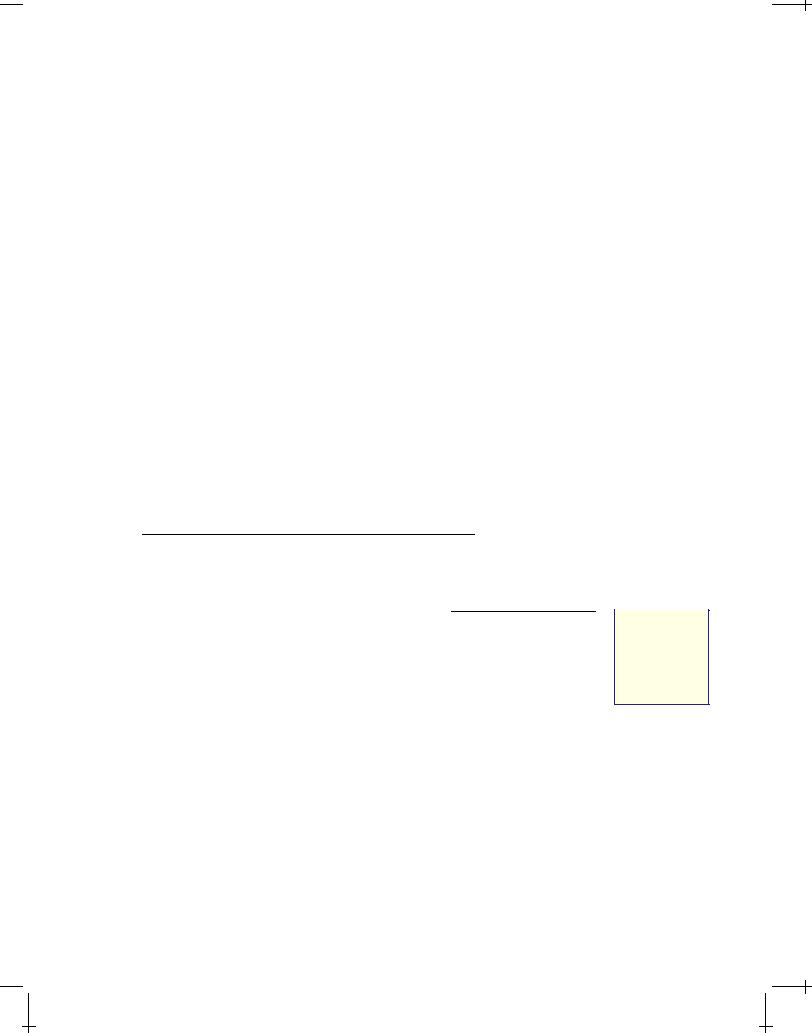
electrodynamics / Electromagnetic Field Theory - Bo Thide
.pdf
1.3 ELECTRODYNAMICS |
13 |
|
allowing us to rewrite Equation (1.32) on the facing page in the following way:
|
C EEMF dl = |
d |
|
|
|||||||
E(t;x) = |
|
S B dS |
|
|
|||||||
dt |
|
(1.35) |
|||||||||
|
@ |
|
|
|
|
|
|
|
|
||
|
B dS S r (B v) dS |
|
|||||||||
= S |
|
|
|||||||||
@t |
|
||||||||||
With Stokes' theorem applied to the last integral, we finally get |
|
||||||||||
E(t;x) = |
C EEMF dl = S |
@ |
|
B dS |
C(B v) dl |
(1.36) |
|||||
@t |
|||||||||||
or, rearranging the terms, |
|
|
|||||||||
|
@ |
|
|
|
|
||||||
C(EEMF v B) dl = S |
|
B dS |
|
(1.37) |
|||||||
@t |
|
||||||||||
where EEMF is the field which is induced in the “loop,” i.e., in the moving system. The use of Stokes' theorem “backwards” on Equation (1.37) above yields
r (EEMF v B) = |
@ |
B |
(1.38) |
|
|||
@t |
|||
In the fixed system, an observer measures the electric field |
|
||
E = EEMF v B |
|
|
(1.39) |
Hence, a moving observer measures the following Lorentz force on a charge q
qEEMF = qE +q(v B) |
(1.40) |
corresponding to an “effective” electric field in the “loop” (moving observer)
EEMF = E +(v B) |
(1.41) |
Hence, we can conclude that for a stationary observer, the Maxwell equation
r E = |
@ |
|
@t B |
(1.42) |
is indeed valid even if the “loop” is moving.
Draft version released 13th November 2000 at 22:01. |
Downloaded from http://www.plasma.uu.se/CED/Book |
|
|

14 |
CLASSICAL ELECTRODYNAMICS |
|
1.3.5 Maxwell's microscopic equations
We are now able to collect the results from the above considerations and formulate the equations of classical electrodynamics valid for arbitrary variations in time and space of the coupled electric and magnetic fields E(t;x) and B(t;x). The equations are
r E
r E + @B
@t r B
@E r B "0 0 @t
=
(t;x)
"0
=
=0
=0j(t;x)
(1.43a)
(1.43b)
(1.43c)
(1.43d)
In these equations (t;x) represents the total, possibly both time and space dependent, electric charge, i.e., free as well as induced (polarisation) charges, and j(t;x) represents the total, possibly both time and space dependent, electric current, i.e., conduction currents (motion of free charges) as well as all atomistic (polarisation, magnetisation) currents. As they stand, the equations therefore incorporate the classical interaction between all electric charges and currents in the system and are called Maxwell's microscopic equations. Another name often used for them is the Maxwell-Lorentz equations. Together with the appropriate constitutive relations, which relate and j to the fields, and the initial and boundary conditions pertinent to the physical situation at hand, they form a system of well-posed partial differential equations which completely determine E and B.
1.3.6 Maxwell's macroscopic equations
The microscopic field equations (1.43) provide a correct classical picture for arbitrary field and source distributions, including both microscopic and macroscopic scales. However, for macroscopic substances it is sometimes convenient to introduce new derived fields which represent the electric and magnetic fields in which, in an average sense, the material properties of the substances are already included. These fields are the electric displacement D and the magnetising field H. In the most general case, these derived fields are complicated nonlocal, nonlinear functionals of the primary fields E and B:
D = D[t;x; E;B] |
(1.44a) |
H = H[t;x; E;B] |
(1.44b) |
Downloaded from http://www.plasma.uu.se/CED/Book |
Draft version released 13th November 2000 at 22:01. |
|
|

1.4 ELECTROMAGNETIC DUALITY |
15 |
|
Under certain conditions, for instance for very low field strengths, we may assume that the response of a substance is linear so that
D = "(t;x)E |
(1.45) |
H = 1(t;x)B |
(1.46) |
i.e., that the derived fields are linearly proportional to the primary fields and that the electric displacement (magnetising field) is only dependent on the electric (magnetic) field.
The field equations expressed in terms of the derived field quantities D and H are
r D = (t;x)
r E + @B = 0
@t
r B = 0
@D
r H @t = j(t;x)
and are called Maxwell's macroscopic equations.
(1.47a)
(1.47b)
(1.47c)
(1.47d)
1.4 Electromagnetic Duality
If we look more closely at the microscopic Maxwell equations (1.48), we see that they exhibit a certain, albeit not a complete, symmetry. Let us for explicitness denote the electric charge density = (t;x) by e and the electric current density j = j(t;x) by je. We further make the ad hoc assumption that there exist magnetic monopoles represented by a magnetic charge density, denoted
m = m(t;x), and a magnetic current density, denoted jm =jm(t;x). With these new quantities included in the theory, the Maxwell equations can be written
r E = |
|
e |
|
(1.48a) |
||
"0 |
|
|||||
r E + |
@B |
= |
0jm |
(1.48b) |
||
|
||||||
@t |
||||||
r B = 0 m |
(1.48c) |
|||||
r B +"0 0 |
@E |
= |
0je |
(1.48d) |
||
@t |
||||||
We shall call these equations the Dirac-Maxwell equations or the electromagnetodynamic equations
Draft version released 13th November 2000 at 22:01. |
Downloaded from http://www.plasma.uu.se/CED/Book |
|
|

16 |
CLASSICAL ELECTRODYNAMICS |
|
Taking the divergence of (1.48b), we find that |
|
||
r (r E) = |
@ |
(r B) 0r jm 0 |
(1.49) |
@t |
|||
where we used the fact that, according to formula (M.82) on page 175, the divergence of a curl always vanishes. Using (1.48c) to rewrite this relation, we obtain the equation of continuity for magnetic monopoles
@m |
+r jm = 0 |
(1.50) |
@t |
which has the same form as that for the electric monopoles (electric charges) and currents, Equation (1.21) on page 9.
We notice that the new Equations (1.48) on the preceding page exhibit the following symmetry (recall that "0 0 = 1=c2):
E ! cB |
(1.51a) |
cB !E |
(1.51b) |
c e ! m |
(1.51c) |
m !c e |
(1.51d) |
cje ! jm |
(1.51e) |
jm !cje |
(1.51f) |
which is a particular case ( = =2) of the general duality transformation (depicted by the Hodge star operator)
?E = Ecos +cBsin |
(1.52a) |
c?B = Esin +cBcos |
(1.52b) |
c? e = c e cos + m sin |
(1.52c) |
? m = c e sin + m cos |
(1.52d) |
c?je = cje cos +jm sin |
(1.52e) |
?jm = cje sin +jm cos |
(1.52f) |
which leaves the Dirac-Maxwell equations, and hence the physics they describe (often referred to as electromagnetodynamics), invariant. Since E and je are (true or polar) vectors, B a pseudovector (axial vector), e a (true) scalar, then m and , which behaves as a mixing angle in a two-dimensional “charge space,” must be pseudoscalars and jm a pseudovector.
Downloaded from http://www.plasma.uu.se/CED/Book |
Draft version released 13th November 2000 at 22:01. |
|
|

1.4 ELECTROMAGNETIC DUALITY |
17 |
|
DUALITY OF THE ELECTROMAGNETODYNAMIC EQUATIONS |
|
|
|
|
||||||||||||||||||||||||||
|
|
|
|
|||||||||||||||||||||||||||
Show that the symmetric, electromagnetodynamic form of Maxwell's equations (the |
|
|
||||||||||||||||||||||||||||
Dirac-Maxwell equations), Equations (1.48) on page 15 are invariant under the duality |
|
EXAMPLE |
||||||||||||||||||||||||||||
transformation (1.52). |
|
|
|
|
|
|
|
|
|
|
|
|
|
|
|
|
|
|
|
|
|
|
|
|
|
|
1.1 |
|||
Explicit application of the transformation yields |
|
|
|
|
|
|
|
|
|
|
|
|
||||||||||||||||||
r ?E = r (Ecos +cBsin ) = |
e |
|
|
cos +c 0 m sin |
|
|
|
|||||||||||||||||||||||
|
|
|
|
|
||||||||||||||||||||||||||
"0 |
|
|
(1.53) |
|
|
|||||||||||||||||||||||||
1 |
|
|
|
|
|
|
|
1 |
|
|
|
|
|
|
|
|
? e |
|
|
|||||||||||
|
|
|
|
|
e cos + |
|
|
|
|
|
|
|
|
|
|
|
||||||||||||||
= |
|
|
|
|
|
|
|
|
m sin = |
|
|
|
|
|
|
|
|
|||||||||||||
|
|
|
|
|
|
|
|
|
|
|||||||||||||||||||||
"0 |
|
|
c |
"0 |
|
|
|
|
|
|
||||||||||||||||||||
r ?E + |
@?B |
|
|
|
|
|
|
|
@ |
1 |
|
|
|
|
|
|||||||||||||||
|
= r |
(Ecos +cBsin ) + |
|
|
|
|
|
|
Esin +Bcos |
|
|
|
||||||||||||||||||
@t |
@t |
c |
|
|
||||||||||||||||||||||||||
|
|
|
@B |
|
|
|
|
|
1 @E |
|
|
|
||||||||||||||||||
|
|
= |
|
|
|
|
cos 0jm cos + |
|
|
|
|
|
sin +c 0je sin |
(1.54) |
|
|
||||||||||||||
|
|
@t |
c |
|
|
@t |
|
|
||||||||||||||||||||||
|
|
|
|
|
1 @E |
@B |
|
|
|
|
|
|
|
|
|
|
|
|
||||||||||||
|
|
|
|
|
|
sin + |
|
|
cos = 0jm cos +c 0je sin |
|
|
|||||||||||||||||||
|
|
c |
@t |
|
@t |
|
|
|||||||||||||||||||||||
|
|
= 0( cje sin +jm cos ) = 0?jm |
|
|
|
|||||||||||||||||||||||||
and analogously for the other two Dirac-Maxwell equations. |
QED |
|
|
|||||||||||||||||||||||||||
END OF EXAMPLE 1.1
MAXWELL FROM DIRAC-MAXWELL EQUATIONS FOR A FIXED MIXING ANGLE |
|
|
|
Show that for a fixed mixing angle such that |
|
m =c e tan |
(1.55a) |
jm =cje tan |
(1.55b) |
the Dirac-Maxwell equations reduce to the usual Maxwell equations. |
|
Explicit application of the fixed mixing angle conditions on the duality transformation (1.52) on the facing page yields
EXAMPLE
1.2
? e = e cos + |
1 |
m sin = e cos + |
1 |
c e tan sin |
|
|
||||||||
|
|
|
|
|||||||||||
|
|
|
c |
|
|
|
c |
|
(1.56a) |
|||||
|
1 |
|
|
|
|
|
1 |
|
|
|
||||
= |
( e cos2 + e sin2 |
) = |
|
e |
|
|
||||||||
|
|
|
|
|||||||||||
|
cos |
|
|
cos |
|
|
||||||||
? m = c e sin +c e tan cos = c e sin +c e sin =0 |
|
(1.56b) |
||||||||||||
?je =je cos +je tan sin = |
1 |
(je cos2 +je sin2 ) = |
1 |
je |
(1.56c) |
|||||||||
cos |
cos |
|||||||||||||
|
|
|
|
|
|
|
|
|
|
|
|
|||
?jm = cje sin +cje tan cos = cje sin +cje sin =0 |
|
(1.56d) |
||||||||||||
Hence, a fixed mixing angle, or, equivalently, a fixed ratio between the electric and magnetic charges/currents, “hides” the magnetic monopole influence ( m and jm) on the dynamic equations.
We notice that the inverse of the transformation given by Equation (1.52) on page 16
Draft version released 13th November 2000 at 22:01. |
Downloaded from http://www.plasma.uu.se/CED/Book |
|
|

18 |
CLASSICAL ELECTRODYNAMICS |
|
yields |
|
E = ?Ecos c?Bsin |
(1.57) |
This means that |
|
r E = r ?Ecos cr ?Bsin |
(1.58) |
Furthermore, from the expressions for the transformed charges and currents above, we find that
r ?E = |
? e |
= |
1 e |
(1.59) |
||
"0 |
cos |
|
"0 |
|||
and |
|
|
|
|
|
|
r ?B = 0? m =0 |
(1.60) |
|||||
so that |
|
|
|
|
|
|
1 e cos 0 = e cos "0 "0
and so on for the other equations.
(1.61)
QED
END OF EXAMPLE 1.2
EXAMPLE
1.3
The invariance of the Dirac-Maxwell equations under the similarity transformation means that the amount of magnetic monopole density m is irrelevant for the physics as long as the ratio m=e = tan is kept constant. So whether we assume that the particles are only electrically charged or have also a magnetic charge with a given, fixed ratio between the two types of charges is a matter of convention, as long as we assume that this fraction is the same for all particles. Such particles are referred to as dyons. By varying the mixing angle we can change the fraction of magnetic monopoles at will without changing the laws of electrodynamics. For =0 we recover the usual Maxwell electrodynamics as we know it.
THE COMPLEX FIELD SIX-VECTOR |
|
|
|
|
|
The complex field six-vector |
|
|
F(t;x) =E(t;x) +icB(t;x) |
(1.62) |
|
where E;B 2 3 and hence F 2 3 , has a number of interesting properites: |
|
|
1. The inner product of F with itself |
|
|
F F = (E +icB) (E +icB) = E2 c2 B2 +2icE B |
(1.63) |
|
is conserved. I.e., |
|
|
Downloaded from http://www.plasma.uu.se/CED/Book |
Draft version released 13th November 2000 at 22:01. |
|
|

1.4 ELECTROMAGNETIC DUALITY |
19 |
|
|
E2 c2 B2 = Const |
(1.64a) |
|
E B = Const |
(1.64b) |
|
as we shall see later. |
|
2. |
The inner product of F with the complex conjugate of itself |
|
|
F F =(E +icB) (E icB) = E2 +c2 B2 |
(1.65) |
|
is proportional to the electromagnetic field energy. |
|
3. |
As with any vector, the cross product of F itself vanishes: |
|
|
F F = (E +icB) (E +icB) |
|
= |
2 |
B B |
+ |
ic(E B) |
+ |
ic(B E) |
(1.66) |
|
E E c |
|
|
|
=0 +0 +ic(E B) ic(E B) = 0
4.The cross product of F with the complex conjugate of itself
F F = (E +icB) (E icB)
= |
E E |
+ |
2 |
B B ic(E B) |
+ |
ic(B E) |
(1.67) |
|
|
c |
|
|
= 0 +0 ic(E B) ic(E B) = 2ic(E B)
is proportional to the electromagnetic power flux.
END OF EXAMPLE 1.3
DUALITY EXPRESSED IN THE COMPLEX FIELD SIX-VECTOR
Expressed in the complex field vector, introduced in Example 1.3 on the facing page, the duality transformation Equations (1.52) on page 16 become
?F = ?E +ic?B = Ecos +cBsin iEsin +icBcos |
(1.68) |
||||||||
= E(cos |
|
isin ) +icB(cos |
|
isin ) = e i (E +icB) =e i F |
|
||||
|
|
|
|
|
|
|
|
||
from which it is easy to see that |
|
|
|
|
|
||||
? |
|
2 |
i |
F |
i |
F = jFj2 |
(1.69) |
||
?F ?F = F = e |
e |
||||||||
while |
|
|
|
|
|
|
|
|
|
?F ?F =e2i F F |
|
|
|
|
|
|
(1.70) |
||
EXAMPLE
1.4
Furthermore, assuming that = (t;x), we see that the spatial and temporal differenti-
Draft version released 13th November 2000 at 22:01. |
Downloaded from http://www.plasma.uu.se/CED/Book |
|
|

20 |
CLASSICAL ELECTRODYNAMICS |
|
ation of ?F leads to |
|
|
|
|
|
|
|
|
|
|
|
|
@?F |
|
|
@ |
@F |
|
|
|
|||
@t?F |
|
= |
i |
|
e i F +e i |
|
|
(1.71a) |
|||
@t |
@t |
@t |
|||||||||
@ ?F r ?F = ie i r F +e i r F |
(1.71b) |
||||||||||
@ ?F r ?F = ie i r F +e i r F |
(1.71c) |
||||||||||
which means that @ ?F transforms as ?F itself if is time-independent, and that r |
|
?F |
|||||||||
? |
t |
|
? |
F itself if is space-independent. |
|
|
|||||
and r F transform as |
|
|
|
|
|||||||
END OF EXAMPLE 1.4
Bibliography
[1]R. BECKER, Electromagnetic Fields and Interactions, Dover Publications, Inc., New York, NY, 1982, ISBN 0-486-64290-9.
[2]W. GREINER, Classical Electrodynamics, Springer-Verlag, New York, Berlin, Heidelberg, 1996, ISBN 0-387-94799-X.
[3]E. HALLÉN, Electromagnetic Theory, Chapman & Hall, Ltd., London, 1962.
[4]J. D. JACKSON, Classical Electrodynamics, third ed., Wiley & Sons, Inc., New York, NY . . . , 1999, ISBN 0-471-30932-X.
[5]L. D. LANDAU, AND E. M. LIFSHITZ, The Classical Theory of Fields, fourth revised English ed., vol. 2 of Course of Theoretical Physics, Pergamon Press, Ltd., Oxford . . . , 1975, ISBN 0-08-025072-6.
[6]J. C. MAXWELL, A Treatise on Electricity and Magnetism, third ed., vol. 1, Dover Publications, Inc., New York, NY, 1954, ISBN 0-486-60636-8.
[7]D. B. MELROSE, AND R. C. MCPHEDRAN, Electromagnetic Processes in Dispersive Media, Cambridge University Press, Cambridge . . . , 1991, ISBN 0-521- 41025-8.
[8]W. K. H. PANOFSKY, AND M. PHILLIPS, Classical Electricity and Magnetism, second ed., Addison-Wesley Publishing Company, Inc., Reading, MA . . . , 1962, ISBN 0-201-05702-6.
[9]J. SCHWINGER, A magnetic model of matter, Science 165 (1969).
[10]J. SCHWINGER, L. L. DERAAD, JR., K. A. MILTON, AND W. TSAIYANG ,
Classical Electrodynamics, Perseus Books, Reading, MA, 1965, ISBN 0-7382- 0056-5.
Downloaded from http://www.plasma.uu.se/CED/Book |
Draft version released 13th November 2000 at 22:01. |
|
|

1.4 BIBLIOGRAPHY |
21 |
|
[11]J. A. STRATTON, Electromagnetic Theory, McGraw-Hill Book Company, Inc., New York, NY and London, 1953, ISBN 07-062150-0.
[12]J. VANDERLINDE, Classical Electromagnetic Theory, John Wiley & Sons, Inc., New York, Chichester, Brisbane, Toronto, and Singapore, 1993, ISBN 0-471- 57269-1.
Draft version released 13th November 2000 at 22:01. |
Downloaded from http://www.plasma.uu.se/CED/Book |
|
|

22 |
CLASSICAL ELECTRODYNAMICS |
|
Downloaded from http://www.plasma.uu.se/CED/Book |
Draft version released 13th November 2000 at 22:01. |
|
|
